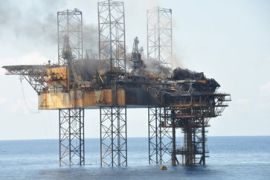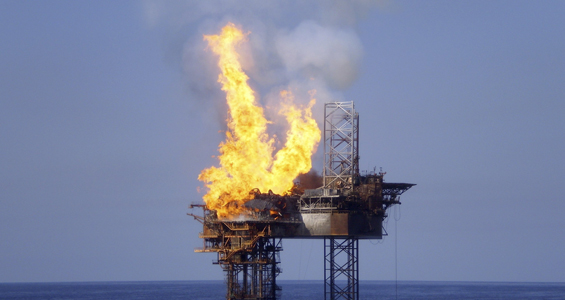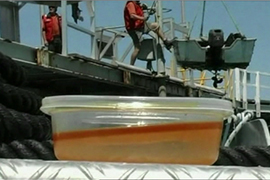Timor spill creates ‘sea of oil’
Campaigners tell Al Jazeera that slick from leaking oil rig has reached Indonesia.

 |
| A fire broke out on the oil rig in the Timor Sea as crews attempted to plug the oil leak [Reuters] |
As specialist teams extinguished a blaze on an oil rig in the Timor Sea, the 610,000sqkm expanse of water is now, according to campaigners, home to one of the worst environmental disasters in Australian maritime history.
The West Atlas rig on the Montara oil field, located around 690km near the city of Darwin, leaked millions of litres of oil, creating a slick as wide as 15,000sqkm.
Keep reading
list of 4 itemsTurtles swimming to extinction in Malaysia as male hatchlings feel heat
Could shipping containers be the answer to Ghana’s housing crisis?
Thousands protest against over-tourism in Spain’s Canary Islands
It ruptured on August 21 and PTTEP, the rig’s operator, has not revealed why it occurred.
But what is now in full view is the “sea of oil” and the long-term impact scientists have compared to the Exxon Valdez disaster off the Alaskan coast in 1989, where ecological damage is still being felt 20 years later.
Environmental groups say marine animals are swimming through the slick, while PTTEP reported in a statement last week of high rates mortality among sea birds.
Marine life at risk
The environmental campaign group, World Wildlife Fund (WWF), conducted the first expedition to the area last month and Gilly Llewellyn, director of conservation, told Al Jazeera that more species were at risk.
“Hundreds, if not thousands, of dolphins, sea birds and sea snakes are being exposed to toxic oil,” she said.
“The critical issue is the long-term impact of this slick on a rich, marine ecosystem, taking into consideration the magnitude and duration of the incident.”
As sweet light crude seeped into the Timor Sea for over two months, it hardly registered on the Australian and international radar.
 |
| Environmentalists fear for the lives of thousands of species affected by the spill |
“If the spill occurred close to Australian shores and surfers in the vicinity were somehow inconvenienced by the spill, there would be outrage,” Llewellyn said.
“But since it was so far out to sea, it was more a case of ‘out of sight, out of mind’.”
However, four weeks into the spill, the Australian Maritime Safety Authority submitted a report to the Indonesian government, informing them that volumes of oil had entered the country’s Exclusive Economic Zone.
According to Ferdi Tanoni, director of the West Timor Care Foundation, fishermen operating near the Indonesian island of Roti encountered a slick that had damaged hundreds of hectares of ready-to-harvest seaweed.
“Seaweed is one of the area’s prime commodities, and it has been polluted. If the farmers fail to harvest their seaweed, they would incur losses of up to billions of rupiah [Indonesian currency],” he told Al Jazeera.
Tanoni also said at least 7,000 traditional fishermen and more than 10,000 coastal communities rely on the Timor Sea for a living.
Produce ‘declining’
Tanoni said that the amount of fish caught in the area dramatically declined as the oil leak spread.
“They [the fishermen] normally catch 100 to 120 fish per week. Since the spill, they are finding it hard to catch 25,” he said.
The regional impact has also prompted East Timor to demand compensation from Australia for any environmental damage caused by the oil leak.
The rig lies 250km from East Timor’s coastline.
| In video |
|
Al Jazeera interviews the World Wildlife Fund on the Timor Sea oil spill |
Australian officials said on Thursday that only small patches of “weathered oil” had gone into Indonesia’s economic zone, and that was about 100km from Roti.
The situation took a dramatic turn for the worse last week when a portion of the rig caught on fire as crews embarked on their fifth attempt to stop the leak.
The blaze had been burning for two days and the company said that it feared a possible collapse of the rig could worsen the impact of the leak.
But just how much oil that spilled into the Timor Sea remains a source of contention.
PTTEP estimates that betwen 300 and 400 barrels of oil a day was pouring out of the well, but a survey conducted by the Australian department of resources and energy said that it could be at least 2,000 barrels.
The company also estimated the spill could have leaked 3.7 million litres of oil since August.
However, opposition groups in Australia say the actual figure is between 10 and 20 million litres.
Contested numbers
Rachel Siewert, a senator from the Australian Greens party, said officials from the resources and energy department told a senate hearing in Canberra that PTTEP failed to give them a basis for its calculations on the rate of oil flow.
“It’s important to determine how much has leaked because it can give us a picture of just how serious the long-term effects will be,” she told Al Jazeera.
“If the department’s figures are used, up to 20 million litres of oil have spilled into the sea since August.”
 |
| Sweet, light crude had been spilling from the West Atlas rig since August |
PTTEP continues to defend its handling of the spill, saying it has gone “by the book”.
But as oil continued to seep from the West Atlas rig, PTTEP was given access to more Australian oil fields.
Last month, the government handed PTTEP control of five new exploration licences and several oilfields, totalling an extra 1,480sqkm of water near the formerly leaking rig.
The deal has prompted concern from scientists and environmentalists, such as Euan Harvey, associate professor of marine ecology at the University of Western Australia.
”They need to demonstrate they cannot impact on others’ livelihoods or on the ecosystem, and at the moment, [PTTEP] demonstrated very clearly that they can’t do that,” he said.
Access to the the Timor Sea’s resources has been contested for decades. As hundreds of companies vie for a share, campaigners fear this may result in the transformation of what was once was a thriving ecosystem, to an area littered with oil wells.